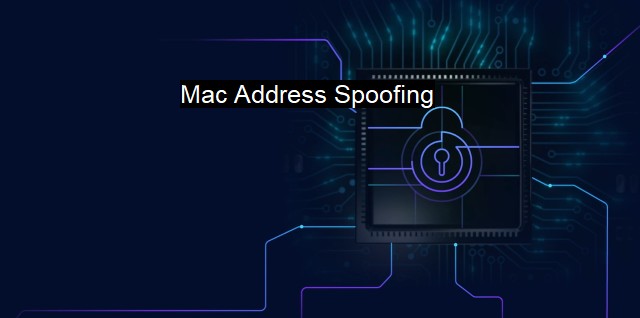What is Mac Address Spoofing?
Understanding MAC Address Spoofing: Risks and Prevention Strategies for Network Security
One term that often makes its way to the forefront is "MAC address spoofing". To properly understand the term, it's essential to break it down into its central components, starting with the MAC address.A Media Access Control (MAC) address is a 12-character unique identifier assigned to each specific network interface controller (NIC), which could be a network card or a Wi-Fi chip on any device connected to a network. This address is leveraged for communication on a network segment and assures that data packets reach the right destination.
Now, spoofing in cybersecurity signifies a malicious practice where a perpetrator falsifies data to masquerade as an authentic source. Combined, MAC address spoofing thus involves altering the existing MAC Address of a network interface on a networked device. It masks the innate MAC address with a new one, which could pertain to another device, thus seemingly changing the 'identity' of the device on the network.
Cybercriminals often resort to MAC address spoofing intending to evade tracking, bypass network restrictions, or impersonate other devices. Since the MAC address functions as a unique identifier for devices, attackers manipulate it to make their actions untraceable or infiltrate secured networks. In certain instances, they also apply this technique to stage a denial-of-service (DoS) attack by creating IP network conflicts or to circumvent MAC address filter-protected networks.
Just as spoofing has two sides, it isn't always malevolent. Consider ethical hackers utilizing spoofing for stress testing networks or companies employing it for legitimate reasons like quality assurance tests, customer services, or digital forensics. end-users may spoof their MAC addresses safeguarding their privacy when using public Wi-Fi networks to prevent becoming targets of unwanted tracking or data collection.
The potential malicious undertakings necessitate precautions and countermeasures against MAC address spoofing. Antivirus software and cybersecurity solutions play pivotal roles in securing networks against these threats. Advanced antivirus programs can check data packets to assure their origin and integrity, thereby detecting any unusual changes in MAC addresses used for data transmission.
Intrusion detection/prevention systems (IDS/IPS) are efficient tools for flagging or averting possible spoofing attacks based on network behavior analytics. They monitor network traffic, checking MAC address inconsistencies, irregularly high data packet transmission rates and, abnormal data packet sizes that are indicative of a MAC spoofing attempt. These tools can be particularly handy in identifying stealthy or intricate spoofing attacks that may elude conventional methods of checking exacerbating concerns in MAC address filters or port security.
The implementation of a robust authentication requirement such as IEEE 802.1X port-based security forbids unauthorized devices from connecting to the network; thereby minimizing risks associated with MAC spoofing.
Undeniably, while MAC spoofing is of paramount concern, acknowledging its existence, comprehending its implications, and nullifying its threats, when combined with a vigorous antivirus and cybersecurity solution strategy safeguard network security. Whether used for benign or sinister purposes, a comprehensive understanding of MAC address spoofing helps shape more effective cybersecurity strategies for all organizations operating in the digital realm. At the end of the day, vigilance, regular updates, examinations and, the deployment of defensive systems pave the way for a secure network free from the clutches of MAC address spoofing.

Mac Address Spoofing FAQs
What is MAC address spoofing?
MAC address spoofing is a technique used by cybercriminals to modify the MAC address of a device in order to impersonate a different device on a network. The purpose of MAC address spoofing is to bypass security measures such as firewalls or access controls.Why is MAC address spoofing a cybersecurity concern?
MAC address spoofing is a cybersecurity concern because it allows cybercriminals to disguise their activities on a network by hiding their actual identity. This means that they can launch attacks (such as phishing, malware or ransomware) without being traced.How can I detect if MAC address spoofing has occurred on my network?
There are several methods you can use to detect MAC address spoofing on your network, such as monitoring your network for unusual traffic, using network monitoring tools or conducting regular security audits. Additionally, some antivirus software may include features that can detect and prevent MAC address spoofing.How can I protect my network from MAC address spoofing?
There are several measures you can take to protect your network from MAC address spoofing such as implementing access controls, encrypting network traffic, using secure authentication methods, and ensuring that all devices on your network have up-to-date antivirus software. Additionally, you can implement MAC address filtering, which only allows devices with pre-approved MAC addresses to access your network.| | A | | | B | | | C | | | D | | | E | | | F | | | G | | | H | | | I | | | J | | | K | | | L | | | M | |
| | N | | | O | | | P | | | Q | | | R | | | S | | | T | | | U | | | V | | | W | | | X | | | Y | | | Z | |
| | 1 | | | 2 | | | 3 | | | 4 | | | 7 | | | 8 | | |||||||